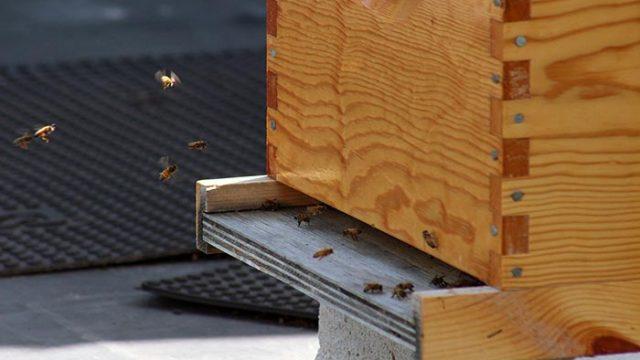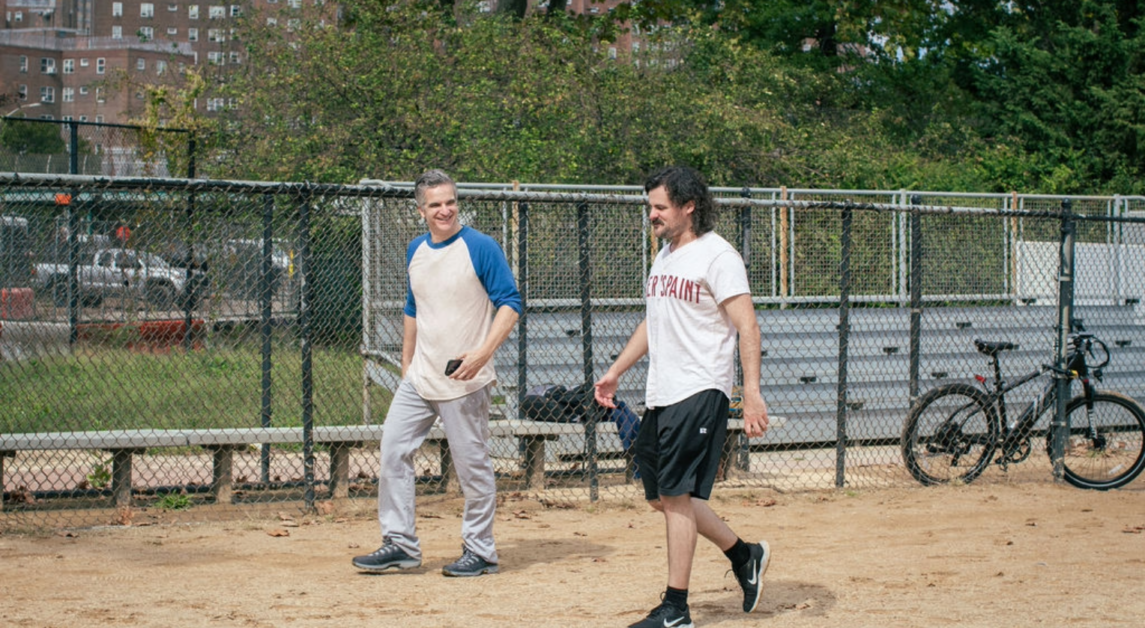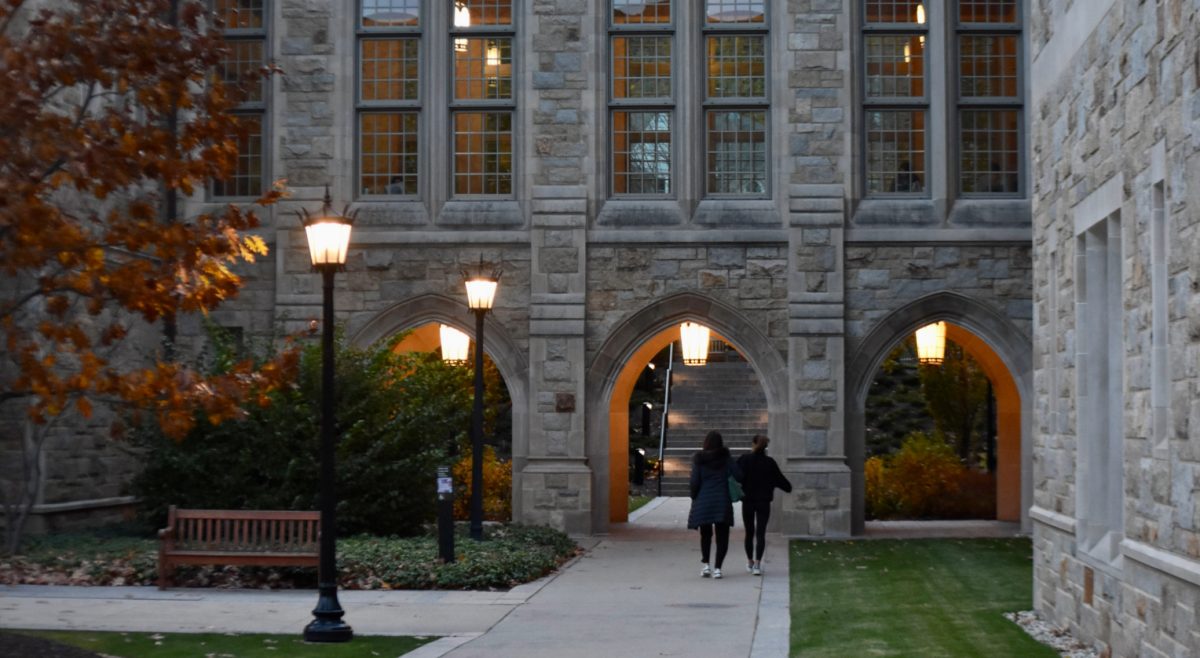This year, Boston College welcomed an additional 10,000 new Eagles to campus with the installation of an “urban beehive” on the roof of Fulton Hall. At press time, the bees declined to comment on their new identities as avian predators, preferring instead to buzz around their hive in an assertive display of character. The bees’ tenacity in the face of rebranding at the hands of the University and—on a more serious note—a looming swarm of environmental perils, makes one wonder if it’s time to rename our mascot Baldwin the Bee.
History of a Hive
BC’s Office of Sustainability doesn’t get much time in the limelight, but that doesn’t deter sustainability director Robert Pion from steadfastly working with students, faculty, and staff on various initiatives to raise awareness of environmental and sustainability issues in the BC community. But if you were to ask him seven years ago, “sustainability director” was a career that never would have crossed his mind.
“My work as a designer and project manager were instrumental in my growing awareness that campuses have to be sustainable,” Pion said.
Trained in architectural design, Pion got his start at BC 29 years ago in facilities services, working his way up to become project manager to oversee numerous in-house renovations. It was during this time that he became more aware of how efficiently resources are used and reused in the construction industry. After developing an interest in designing eco-friendly, “green” buildings, Pion began collaborating with BC’s first sustainability director.
“Before becoming sustainability director myself, the director at the time and I shared interest in sustainability programs and worked together on a number of initiatives,” Pion said.
This meeting of the minds made the Office of Sustainability what it is today, with Pion now entering his seventh year as director.
So when Fred and Donna Seigel, donors and current BC parents, came up to Pion offering to pay for the installation and maintenance of an urban beehive on top of one of the academic buildings, it was an offer he couldn’t refuse. Earlier this year, a beehive was up and running on top of Fulton after three months of negotiation. The building was chosen as the optimal place for the hive because of its easy rooftop access, level rooftop surface, relative seclusion, and direct exposure to sunlight, joining other similarly adorned buildings in major cities such as Boston, New York, Washington, D.C., and San Francisco. The Fulton hive is one of many manufactured by the Boston-based company Best Bees. The company is collaborating with the Seigels in their mission to establish urban hives to supplement the dwindling global bee population and to study the behavior of bees in urban environments.
Beekeepers from the company regularly tend to the hive, monitoring the health and productivity of the bees on a monthly basis. With the cool days of autumn approaching, hive activity is beginning to slow down as the bees build up their store of honey in preparation for hibernation. Come next spring, the hive should resume its normal buzz of activity to replenish the honey consumed during the winter.

The Secret Life of Bees
Bees’ main food source is the nectar produced by flowers. Because of their foraging habits and ability to fly distances of up to five miles from their hive, bees are also vital pollinators. As they hunt for nectar, they also assist flowers with reproduction by carrying pollen from one flower to fertilize the ovules of another. Most agriculture is dependent upon bees to pollinate crops that come from flowering plants—without bees, there wouldn’t be apples, carrots, tomatoes, squash, or cocoa.
With a rapidly increasing global population comes a greater demand for food, putting pressure on the agricultural industry to produce more crops at a higher risk of pests and diseases that cause extensive and costly damage. In response, federally approved, “eco-friendly” pesticides have been used to protect crops. While these sprays successfully deter invasive species from destroying crops, they also have detrimental effects on bees and other pollinating species. Coupled with the destruction of their natural forest habitats, these populations have experienced a marked decrease over the past several decades, according to surveys conducted by the United States Department of Agriculture (USDA). These sobering statistics have launched movements like establishing urban beehives to raise awareness of the importance of bees in maintaining a healthy environment.
Bees carry nectar back to their hive and deposit it into honeycombs, wax compartments constructed on the interior of the hive. An average hive is as large as a kitchen trash can and houses 10,000 to 15,000 bees. With their collective body heat, the inside temperature is a sweltering 95 degrees Fahrenheit. Bees maintain the hive temperature by beating their wings, which thickens the nectar into honey as water evaporates. Honey acquires its recognizable appearance and viscosity and is ready to be harvested when it reaches a water content of approximately 15 percent.
Apiculture, colloquially known as beekeeping, has been practiced in various human societies since the development of agriculture and domestication of animals. The method of housing bees in containers and harvesting the honey has remained the same, though the material of the artificial hives has changed. Modern hives are constructed out of wood and resemble a filing cabinet with stacked drawers called “supers” containing several movable frames. The frames are constructed of wire, wax, and plastic, which the bees use as foundation to build honeycombs. The queen bee, whose sole job is to lay eggs, is isolated from the rest of the hive while worker bees are free to enter and leave the hive and move between frames to tend to the honeycombs. A bee colony in a 3-foot-tall structure like the Fulton hive can produce on average four gallons of honey in a year.

Buzzing Developments
The Fulton hive, while small in stature, has great potential to further the mission of the Office of Sustainability.
“It reinforces the message that we have about the importance of preserving the environment and doing what we can to mitigate detrimental effects resulting in bee colony extinction in the natural environment,” Pion said.
While the hive addresses environmental concerns, it also raises new ones. The long-term effects of the introduction of urban beehives on the status quo of an ecosystem is also an area of interest for researchers, especially their effect on competition among wild bees that have already established hives in the local vicinity. The beehive would offer a new, hands-on experience for students to educate themselves on sustainability and the structures of ecosystems.
“There have been some students who are interested in beehives and beekeeping who’ve contacted me,” Pion said. He would like if the beehive could be used as an educational tool in some science classes, eventually. Along with the vegetable garden on Brighton Campus and the greenhouse in Higgins Hall, the Fulton hive could be a valuable resource as another small-scale model to study the interactions between flora and fauna.
Featured Image by Kaitlin Meeks / Heights Staff
Featured Graphic by Abby Paulson / Heights Editor














EyesOnHives • Sep 12, 2016 at 5:08 pm
This is a wonderful story Kayla! We developed a bee camera that measures the flight activity of beehives and would love to introduce it to you, Robert and the BC team. How might we contact you to continue the conversation?